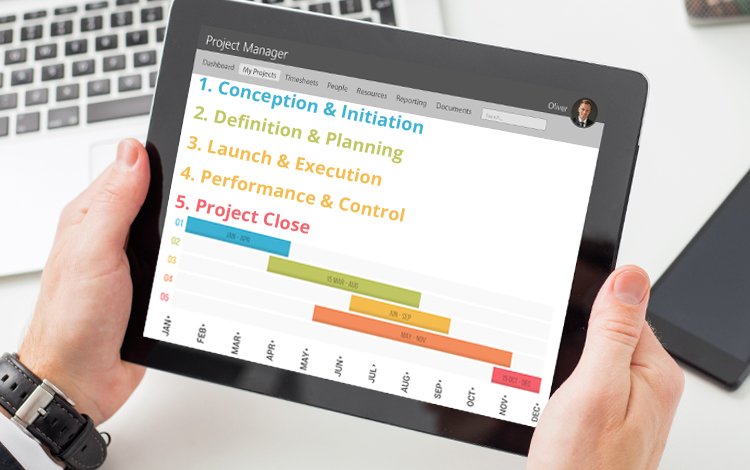
Project management timeline: ordering all phases
Updated on Tuesday, 30th July 2019 13:17
When planning a project timeline, no matter how large or complicated the project is, there are five distinctive phases any project manager should follow, no matter the methodology used. Each stage provides a clear and visible outline of the project at any time during the process.
What are project phases/stages?
Stages help project managers to break a project down into bite-sized pieces that are more easily organised, monitored and managed to a successful completion. Known as the project management lifecycle, each stage builds the roadmap for the project. The five phases are:
- Conception and Initiation
- Definition and Planning
- Launch and Execution
- Performance and Control
- Project Close
Let’s look at each stage in more detail.
- Conception and Initiation
Once the project idea or purpose is decided, the first stage is to map out the concept. Usually, some research is required and this can involve consultation with colleagues and shareholders. Two key questions that need to be asked are: is it feasible and is it of value?
Other aspects to consider at this stage are the cost and project timeline, as well as the impact of the end result. From here, the initial concept goes forward to the decision-making team, who will decide if the project is worthwhile and can be continued.
- Definition and Planning
The second stage is defining and planning the project, from mapping out the scope to developing a schedule and working out the cost, which includes deciding on the resources needed and budget calculation. As with any stage of a project, changes may occur, so remember to build in contingency plans to allow for delays.
There are two methods of planning and setting goals for projects that are popular with project managers – SMART and CLEAR. The SMART acronym stands for:
- Specific – the who, what, where, when, which and why in goal setting.
- Measurable – measuring progress towards a goal’s success.
- Attainable – how the goals will be achieved.
- Realistic – that all team members are working together to achieve the goals.
- Timely – a feasible timeline in which goals can be reached.
The CLEAR acronym, which has become popular in the last few years and adds another dimension to the second stage, stands for:
- Collaborative – ensuring the team is happy and willing to work together.
- Limited – ensuring the scope of the goals is limited so that they are manageable.
- Emotional – forming an emotional connection to the goals by linking with team members’ passions.
- Appreciable – large tasks and activities are broken down in to smaller pieces so that they are achievable.
- Refinable – flexible, adaptable goals that can be fine-tuned in line with changes.
- Launch and Execution
The third stage, once the project’s scope has been agreed, is where the actual physical work of the project starts. Teams meet to learn the project’s timelines and their responsibilities. Tasks are assigned, resources are distributed and other information related to the project is imparted. The project manager ensures that every team member knows what they need to do, and by when.
Most project managers at this stage establish a way of monitoring a project’s progress and communicating with team members regularly, such as project management software that helps a project run smoothly.
- Performance and Control
This stage runs the entire length of the project and is a crucial part of a project’s success. Regular communication with team members is a must. This allows the project manager to monitor, measure and manage progress, and to iron out any issues that may arise.
KPIs (Key Performance Indicators) can be used to assess progress. There are generally four KPI aspects that are followed:
- Project objectives
- Quality deliverables
- Effort and cost tracking
- Project performance
They can help identify areas where deadlines may have been missed, resources weren’t available on time or when a situation needs to be resolved.
- Project Close
The final project management stage is completing the project, with the handover to the owner. At this point, the client will, hopefully, approve and accept the project. The project manager can analyse the project scope. That includes the quality of the work, whether it was completed on time and any internal or external problems.
Contracts with suppliers are terminated and a final budget and project report is produced. All relevant documentation is collated and filed, and the project team is rewarded.
Developing and managing a project based around these five stages gives every project manager the greatest opportunity to bring a project to its successful completion.










 English
English
 German
German
 Dutch
Dutch
 Polish
Polish